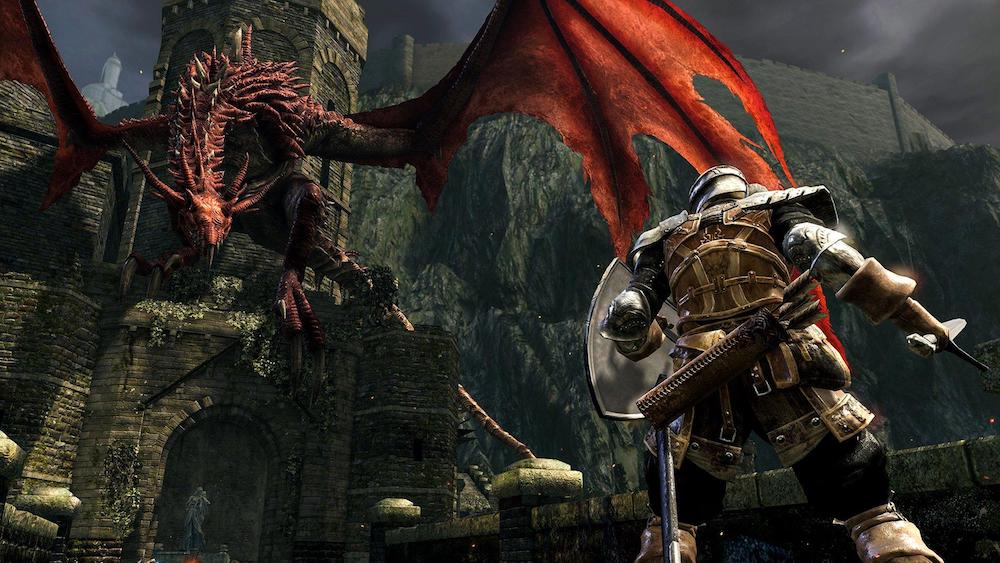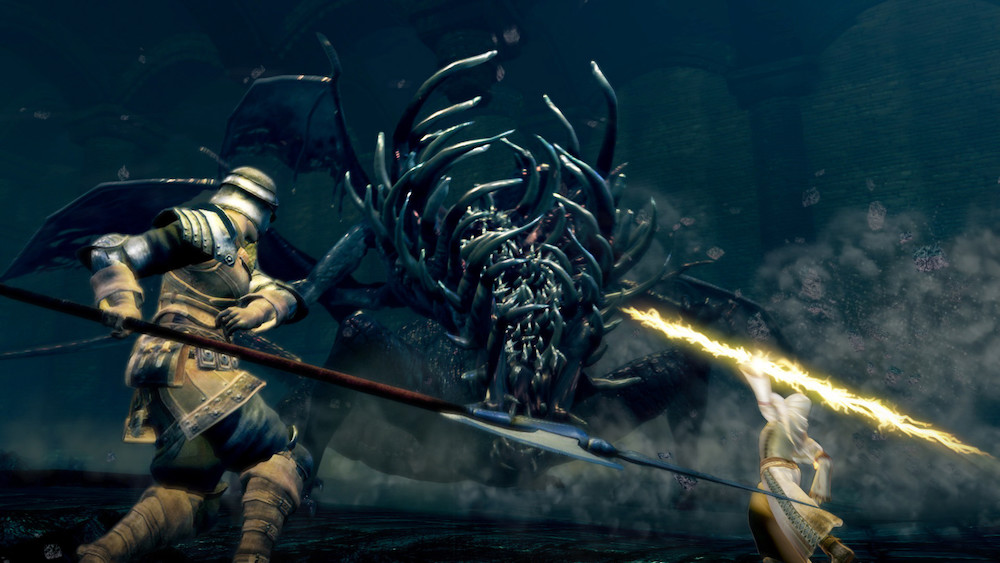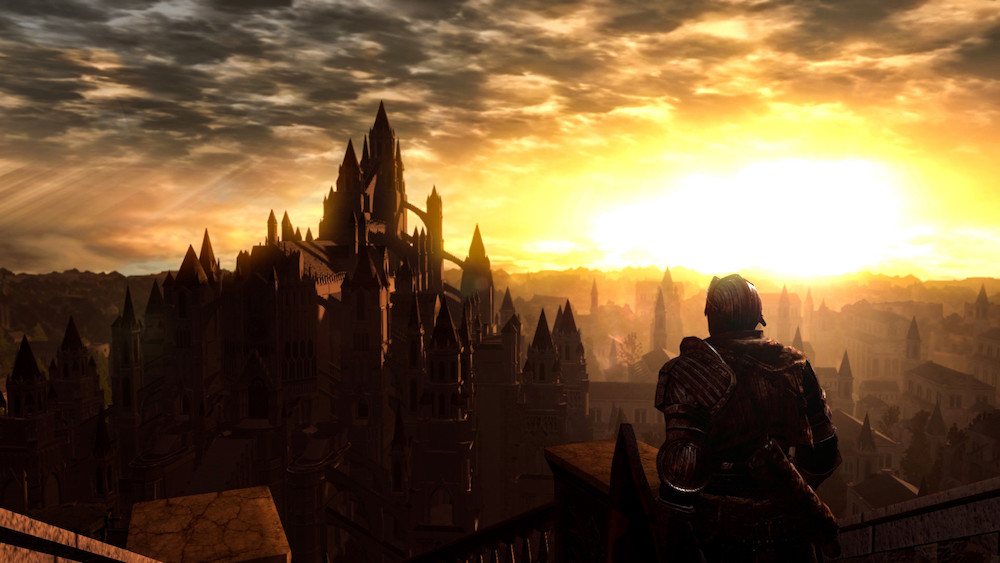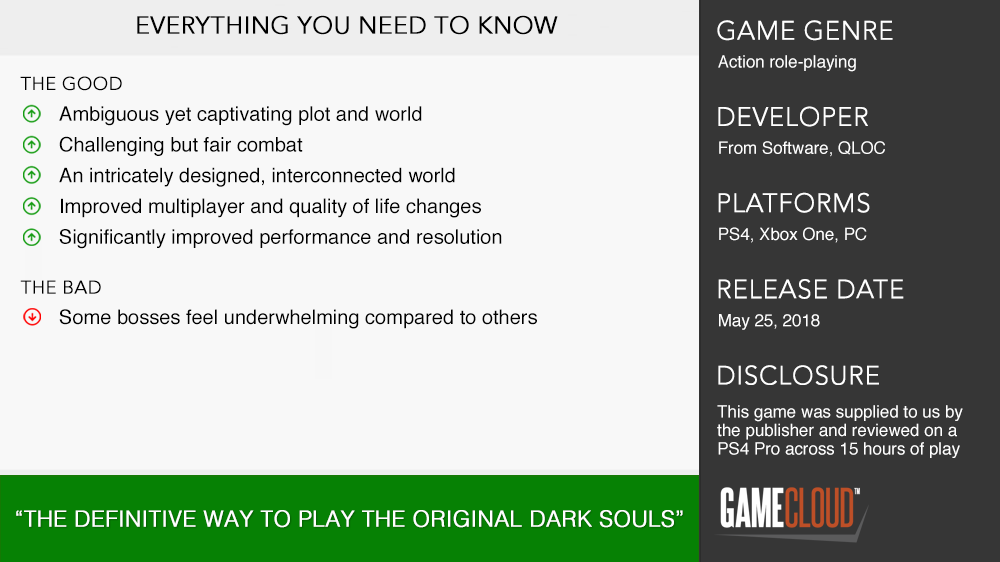
It’s mind-boggling to think that so many people have yet to experience the original Dark Souls despite the boom in popularity the series experienced over the past few years. The first is still widely considered as the best in the trilogy, but its seemingly clunkier combat and technical shortcomings have left it to age a little poorly. It’s hard to go back and experience this gem after playing Bloodborne or Dark Souls III, but Dark Souls Remastered is Bandai Namco’s attempt to make it more accessible to a broader audience with the help of developer QLOC, who are responsible for many fantastic PC ports. What worry I had was quickly replaced by excitement when I started playing, not just for myself, but for the others who have yet to play this incredible game.
After an opening cutscene that briefly explains the history of Lordran, you awaken in the Undead Asylum. You hear from various NPCs that you have a monolithic task ahead of you and that it’s of utmost importance that you complete it. The plot and what it entails is very ambiguous throughout the majority of the game (as expected), and only through searching and extensive reading will you find information about specific areas, enemies, and characters. It’s a captivating way to tell a story as you plunge head first into the unknown. Much like your character, you know nothing, and the simplicity of that works to extreme effect.

The plot has been completely untouched by the remaster. Multiple endings are still present, and so are the same likeable characters and NPCs you’ll run into on your journey. The concept of it all is great, and the implications it makes towards both the player character and the bosses you fight across Lordran are intriguing. It builds an atmosphere that’s unrivalled in the series (not counting Bloodborne) and serves as the start of a tale that spans ages. The package also includes the fantastic Artorias of the Abyss expansion, which is well worth playing after finishing the main story; revolving around the fabled Artorias, who is mentioned multiple times throughout the game.
The first thing that most people think of when they talk or hear about Dark Souls is its difficulty. It’s a challenging game, but a fair one and the rare situations that made some encounters beyond the player’s control have been fixed. It plays like a standard RPG: you pick a class, level up, and continuously improve to overcome the odds thrown against you. Enemies hit hard no matter what level you sit at in comparison to them, and the ever-looming threat of losing precious resources due to one small mistake is nerve-racking. You will hit wall after wall, and the game will continuously beat you into shape so you can overcome that trial.

Combat is simple yet smartly designed around one-on-one encounters. The ability to parry and abuse the invincibility frames in roll dodging allow for a high skill ceiling, and the various builds you can opt to go for create a lot of replayability. When the game throws more than one enemy at you, it forces you out of your comfort zone, and if you panic, you will die. However, if you learn from your experiences and play smart, the satisfaction of overcoming seemingly insurmountable odds feels incredible.
Boss fights are a major highlight, but replaying the game also reminded me that some are far better than others. The first few bosses are minor nuisances once you get to the late game, but specific encounters like the Capra Demon and Moonlit Butterfly feel underwhelming when compared to the stress-inducing fights of Gwyn and the Four Kings. Traversing between these bosses and environments is, has, and always will be a joy. The moment you step out of the elevator from the Undead Parish to Firelink Shrine is one of awe and realisation. Lordran is one sprawling, interconnected world, with a near never-ending amount of shortcuts and secrets to be found.

The differences made to gameplay that come with the remaster are present but very minor aside from one big one. The small quality of life changes implemented in Dark Souls II and III make for an overall smoother and more streamlined experience. None of it makes the game easier, just less clunky regarding inventory management and controls. Multiplayer has seen a bump from four to six players, making for a more chaotic experience regardless of whether you choose to invade or cooperate. The networking has also changed from peer-to-peer to dedicated servers, and the ability to toggle passwords and global matchmaking make it much easier to play with friends.
The most changes have occurred in the technological department in the form of graphics and performance. The visuals have been upscaled to 1080p on standard consoles, while the PS4 Pro, Xbox One X, and PC enjoy 4K resolutions. The game also adopts the lighting engine used in Dark Souls III, and this works wonders for bonfire, magic, and sunlight effects. The standout for me, though, is the consistent frame-rate across all environments. Even Blighttown and Lost Izalith, areas infamously known for their horrible performance, run without an issue. Character models and assets have been completely untouched, and aside from the game looking generally sharper, not much has changed, so don’t expect to be blown away.

If you’ve played the original Dark Souls before, or the Prepare to Die Edition on PC, there really isn’t much here for you in the way of new content. So unless you’re dying to see Blighttown and Lost Izalith run at a steady frame-rate, I’d only recommend it if you’re looking for an excuse to replay the game. However, if you haven’t played this game before, you’d be doing yourself a disservice not to pick it up. A lot of things that kept it from ageing well have been ironed out and make Dark Souls Remastered the definitive way to play this game. If you’ve ever been remotely interested or have played and enjoyed other Souls games, now is the best time to try it.











